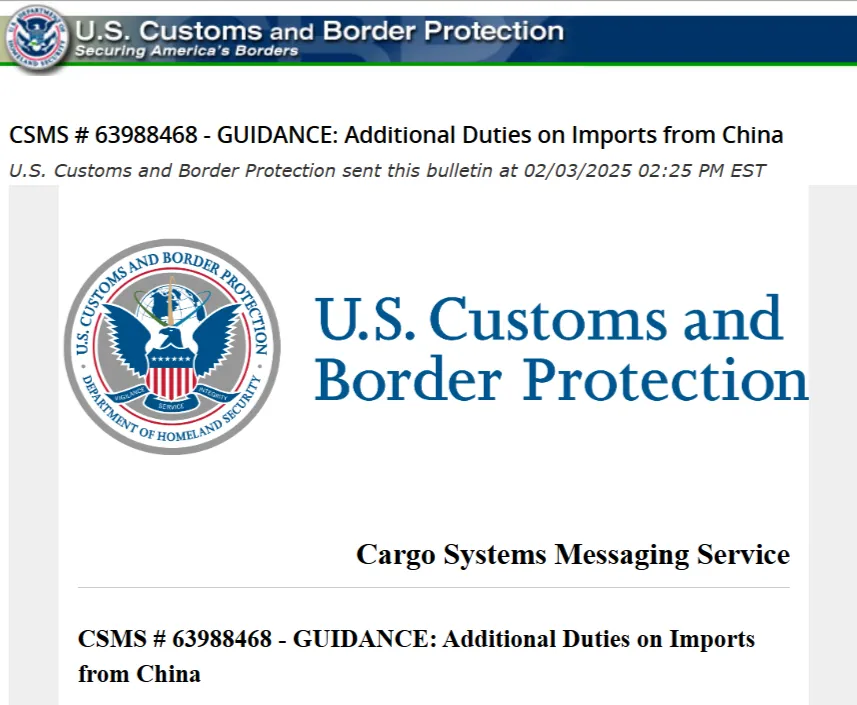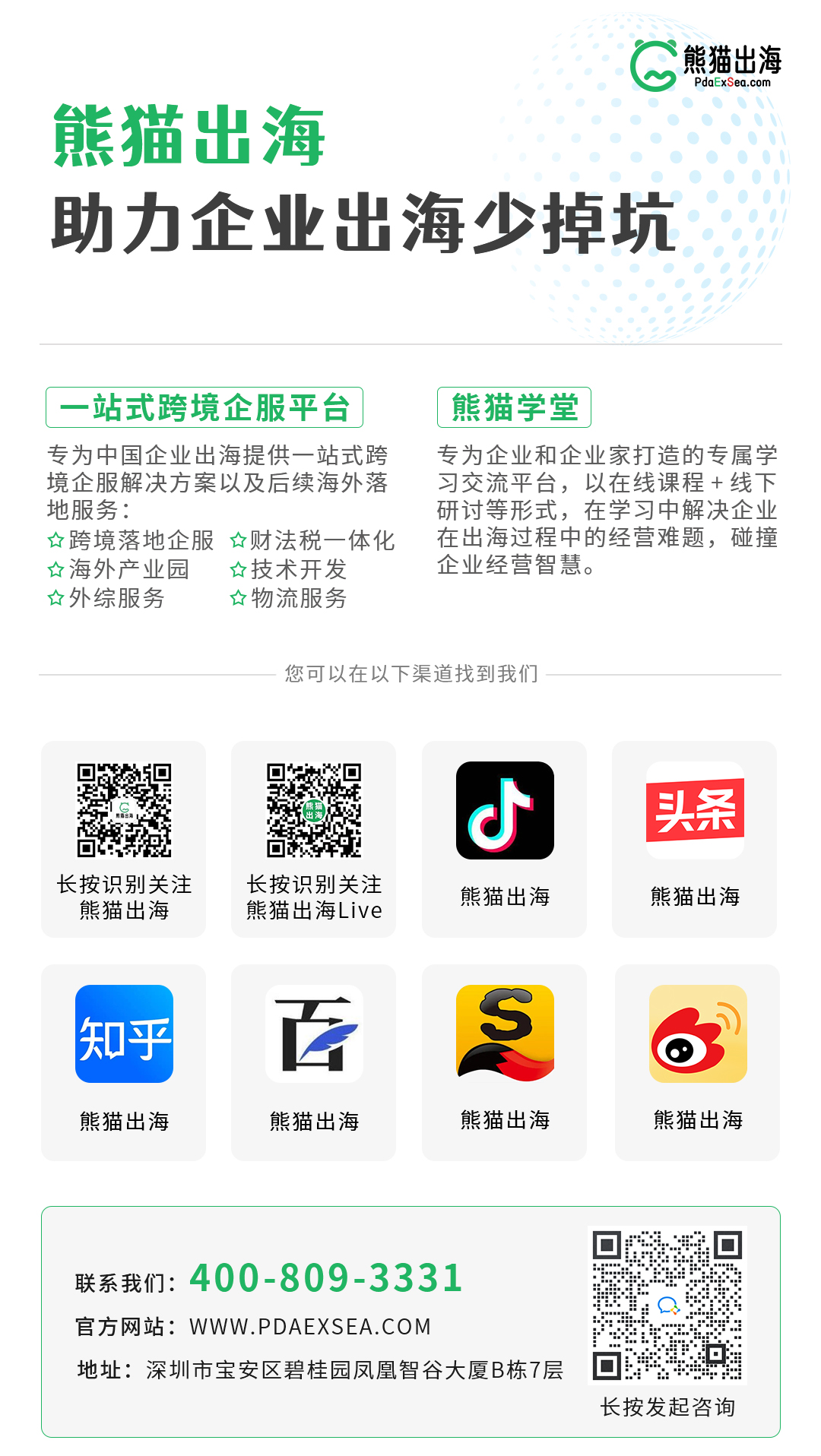"Triple stranglehold" is coming! An in-depth analysis of Trump's new tariff policy: which companies are most hurt?
Tariffs
Trump
2025-02-08 09:33:39
Page view:2496
The tariff stick that Trump has been wielding for a long time has arrived as expected.
1. For the first time, products manufactured, imported and re-exported in Hong Kong are required to be formally declared and subject to additional tariffs;
2. Superimposed taxation, a 10% ad valorem tax rate will be imposed on the existing tariffs (including anti-dumping and countervailing duties);
3. Goods with a value of less than US$800 will not enjoy tariff exemptions.
The policy highlights are as follows:

This advisory was sent by U.S. Customs and Border Protection on February 3, 2025 at 2:25 p.m. EST
1. Policy effective date and scope of implementation
(2) Scope of application: All products originating in China (including the Hong Kong Special Administrative Region) (except the following exemptions and personal carry-on baggage)
(3) Tax rate: A 10% ad valorem tax rate will be imposed on top of the existing tariffs (including anti-dumping and countervailing duties).
2. Exemption categories
- 9903.01.21: Donated materials for humanitarian relief (such as food, clothing, and medicine). The new regulations require companies to accurately classify commodity tariff numbers (such as distinguishing 9903.01.21 humanitarian materials from 9903.01.20 ordinary goods). Incorrect declarations may result in customs clearance delays or fines.
- 9903.01.22: Information materials (including publications, film and television works, news materials, etc.).
- 9903.01.23: Goods that meet the following conditions:
Shipped or in the final transportation stage before February 1, 2025;
Enter the US consumption link between February 4 and March 7, 2025.
3. Special terms and exceptions
Goods declared for entry under Chapter 98 of the U.S. Tariff Schedule (such as re-exported processed goods, temporarily imported items, etc.) are generally exempt from additional tariffs, except for the following subheadings:
- 9802.00.40 (U.S. goods repaired or improved abroad)
- 9802.00.50 (U.S. metal products processed abroad)
- 9802.00.60 (U.S. parts products assembled abroad)
- 9802.00.80 (goods assembled abroad)
- Exception rule: Goods in the above subheadings are subject to a 10% tariff on the value-added processing/assembly generated in China (including the Hong Kong Special Administrative Region).
(2) Foreign Trade Zone (FTZ) Regulations
- Effective February 4, 2025, Chinese (including Hong Kong SAR) goods entering the U.S. FTZ (except those that meet the definition of "domestic status") must be declared as "privileged foreign status" and will pay additional tariffs at the time of final entry for consumption at the then-current rate.
(3) Removal of Minimum Duty Free
- Effective February 4, 2025, goods originating in China (including Hong Kong SAR) will no longer be eligible for duty-free customs clearance with a value of less than US$800. Importers must choose formal customs declaration and pay full taxes and fees, otherwise the customs clearance request will be rejected.
Key issues and risks of the new tariff policy
1. Hong Kong no longer enjoys the treatment of an “independent customs area”
The United States will determine whether the goods are from China or Hong Kong based on supply chain documents such as certificates of origin, orders, packing lists, etc., and will impose additional tariffs.
In 2023, the trade-weighted average tariff rate for goods originating from Hong Kong in the US market was only 1.4%, but if an additional 10% tariff is imposed, the rate will reach 11.4%.
If the goods are mainly manufactured, assembled or processed in the Mainland or Hong Kong, even if they are re-shipped through a third country, they may still be regarded as products of China (including the Hong Kong Special Administrative Region) and will be subject to additional tariffs.
However, the document does not mention Macau, which is also a special administrative region.
2. Cross-border small parcel trade has been hit hard
In particular, merchants who adopt the cross-border small package model (the mainstream model of Temu and Shein) will be greatly affected. Taking Temu's $40 per customer package as an example, if the cost transmission in the industrial chain is not considered, the pricing pressure brought by tariff changes on terminal pricing is 26%, and the price difference between Temu and Amazon for the same product may be narrowed from 40% to 27%.
In addition, the use of formal customs declaration will also have a certain impact on the fulfillment time of cross-border small packages.
Most cross-border e-commerce sellers with Amazon as their main sales channel are in the overseas warehouse stocking model, and are relatively limited by tariff disturbances.
3. After the superposition of tariffs, the average tariff rate for Chinese goods exported to the United States reached 29.3%
Taking women's woven trousers as an example, the tax rate will be: from February 4, 2025
Basic tax rate: 28.6% + 301 tariff rate: 7.5% + 2025 tariff rate: 10% = Total tax rate: 46.1%
Originally, the average tariff rate of taxable goods imported from China by the United States in the previous rounds of tariff increases was about 19.3% by June 2023, which was much higher than 2.3% (most-favored-nation tariff rate) at the beginning of 2018.
Coupled with the 10% ad valorem tariff rate in this round, the average tariff rate of Chinese exports to the United States will reach 29.3%.
4. Increased costs in FTZs
However, the new tax increase regulations clearly state that goods entering the FTZ from China (including the Hong Kong Special Administrative Region) (except for goods that meet the definition of "domestic status") must be declared as "privileged foreign status" and must still pay additional tariffs when they finally enter the country.
This process also increases the complexity and cost of logistics and warehousing.
The impact of the new tariff policy on Chinese enterprises and their response
First, for those companies that are highly dependent on the US export market, the tariff impact is particularly significant. These companies face a dilemma:
On the one hand, paying higher tariffs will directly squeeze their profit margins and may even lead to losses;
On the other hand, in order to avoid tariff costs, they have to consider moving their production lines to other countries, but this involves many challenges such as re-establishing supply chains and adapting to new market environments.
Second, for those products with strong substitutability, once the tariff increase leads to price increases, consumers are likely to turn to cheaper alternatives. For example, some assembly OEM products belong to this category. Their market competition is fierce and consumers are more sensitive to price changes.
Finally, industries with high market share are relatively less affected by this tax increase.
Take DJI as an example. As a leading company in the global drone market, its market position is solid. Even in the face of increased tariffs, it has sufficient bargaining power to maintain its market competitiveness without worrying too much about losing market share.
Trump's term is still more than three years away, and the threat of tariffs is always hanging overhead, but since 2018, Chinese companies have successfully explored a way out:
➤ Reconstructing trade routes: Indirect exports to the United States through third-party re-export channels
➤ Global allocation of production capacity: Layout production in Southeast Asia and other places, completely changing the origin attributes
➤ Market diversification: Accelerate the development of emerging markets such as the "Belt and Road"
In the critical period of the reconstruction of the global order, the survival rules of Chinese companies have changed to: use the flexibility of the industrial chain to hedge policy risks, and use market dispersion to resist unilateral sanctions. Relevant companies need to adjust their corporate strategies as soon as possible to cope with the challenges brought by the new regulations.



